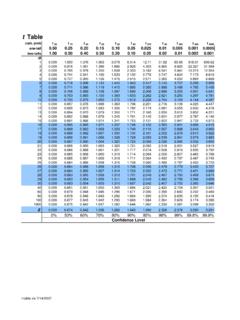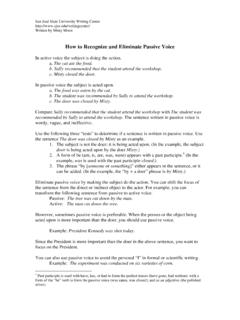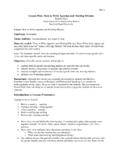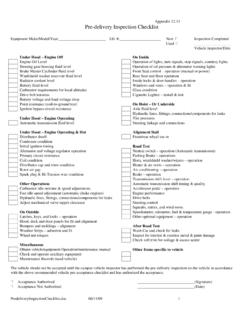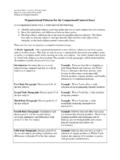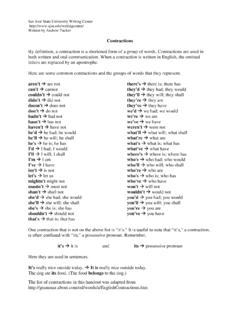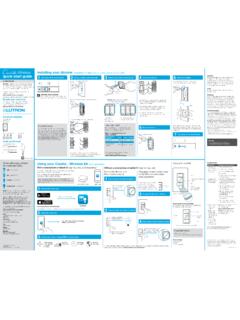Transcription of Introduction To Media - San Jose State University
1 Introduction To Media Tim Hendrick Media Overview and Planning/buying Page 1 AJEEP Media Overview Planning/Buying The Internet Course Description This course is intended to be a survey of the Media planning discipline of advertising. You will learn to solve marketing problems through understanding how the Media operate from the perspective of the advertiser, the agency and the medium itself. We will discuss the planning, selection and evaluation of all major advertising Media and consider the various decisions and problems that arise in those processes. Therefore, the course is designed to cover the fundamentals of Media planning with an emphasis on knowing and understanding Media concepts, numerical analysis, Media research, and strategic Media planning.
2 We will also discuss and review current Media situations in today s world. A combination of conceptual presentations and detailed process-oriented assignments will be used to facilitate understanding of the fundamental concepts. This format will help you develop a sense of judgment that will be used to create a strategic Media plan that will solve a complex marketing problem. Course Goals and Student Learning Objectives By the end you will have examined a wide range of challenges and procedures involved in the process of Media planning/buying and the evaluation of Media plans. The instructor s role in this course is to guide you in a sophisticated understanding of the Media function, from an advertising professional's point of view. Explain the mass Media system, how it works and how advertising practitioners use it to deliver messages to potential consumers.
3 Present the various sources of information which are commonly used to provide answers to important questions about who potential customers are, what Media are they exposed to and how much money should be spent to deliver a message to them. Present the most widely used planning theories and help you see how they apply to different situations. You may also get the opportunity to do a simulated Media project and plan through the use of the online software that accompanies the text. Media Overview and Planning/buying Page 2 Course Content Learning Outcomes You should have a thorough understanding of several Media planning fundamentals 1. The role of Media in delivering messages to customers and potential customers 2. The function and methods employed by advertising agency Media departments 3.
4 The various sources of information necessary to make good Media decisions 4. The complex interrelationships among important factors of Media decision-making 5. The underlying criteria which allow us to evaluate the advantages and failures in data sources, Media research, and theories of Media strategy 6. The development of a sense of judgment when evaluating Media and/or other advertising options 7. The strategic development of a Media plan in response to a marketing/advertising problem Required Texts/Readings Textbook None Other Readings Other Equipment / Material Requirements (Optional) Computer, with full suite of business functional software - Word, XL, Powerpoint Assignments and Grading Policy Insert your enumerations and brief descriptions for the course assignments here, and indicate how each assignment is aligning with the learning outcomes.
5 Include information about due dates and assignment weights. Specify grading policies including how grades are determined, what grades are possible, whether extra credit is available, what the penalty is for late or missed work, and what constitutes a passing grade for the course. Include the date of the final exam/s. If you grade on participation, indicators on how participations will be assessed should be included. Media Overview Planning/Buying The Internet Course Schedule List the agenda for the semester including when and where the final exam will be held. Indicate the schedule is subject to change with fair notice and how the notice will be made available. Class Date Topics, Readings, Assignments, Deadlines 1 Media The Media Age 2 Media and the Marketing of Messages (The Building Blocks) (Strengths & Weaknesses) 3 Modern Media Planning 4 Buying and Selling Media 5 Media Across IMC (Integrated Marketing Communications) 6 7 New Media New/Interactive Media Planning Supplemental Article (Power of Multiple Media ) Key Terms Internet Television Radio Media Medium Vehicle Audience ratings Circulation Fragmentation Target Brief B2B Niche Cookie Chapter one is intended to give an overview of Media as a whole and the different elements that matter in the Media world today.
6 Written in simple form this chapter educates the student on the broad array of choices and why they matter. Almost all Media plans today are multi-dimensional, utilizing numerous elements rather than just one. Consumers today do not get all their information from just one element but from many. It is important to teach students that there are many choices and many reasons why certain Media are effective in reaching a specific target audience. No one Media can solve the communication problem in today s market. The chapter follows on a track of history and concludes with a summation about al the changes in the Media world and the emerging issues between old and new Media . Media Media is CONTENT Media is ENTERTAINMENT Media is MONEY Media is LADY GAGA Media is TARGETING Media is ENGAGEMENT Media is INFLUENCE Media is CONTEXT Media Media is MARKETING Media is RETAIL Media is CELEBRITY Media is PLATFORM Media is DATA Media is PACKAGING Media is SOCIAL Media is PERSONAL Media is YOU The Media Age Agenda n The Media Industry Comes of Age n There is a lot of growth in Media options.
7 We now have the internet, outdoor billboards, mobile phone advertising coming on strong, in-store and shopping mall kiosks, even ads on taxis. n The Technology Engine n Technological advances are driving this change, such as different printing techniques, (color is cheaper) the internet and all the advertising that is now done there, the ipad and new forms of advertising, smart phones, and the ability to choose what we see. All because of more and more storage ability n The Media Whirl n We must keep in mind that the end user, the reader, has different approaches to how they take in information and in what manner do they want it delivered. A successful Media organization must meet these methods or touch points with advertising Media products that will fit into their daily lifestyle.
8 Now lets take the primary Media that we use and discuss them in more detail Television The biggest of course and that which reaches the most people is television n Regular television, which is typically free and broadcast over the airwaves, has been around since the 1920 s and really took off in the 1950 s because of new programming and the availability of cheaper tv s. n Cable TV which is different market by market and is paid for on a monthly basis started in the 1940 s and really took off in the 1980 s. It allows for all kinds of new programming, that generates small but unique audiences. n The next wave is n digital television and interactive via Digital Video Recorders (DVRs) where it automatically records a program for later watching.
9 It will get to the point where you can have an internet connection on screen in the corner of the program and when an ad comes on you can click on it and order the product without interruption in the program. Radio n It used to be big broadcast networks but now it is very local, with local advertisers filling the airwaves. There are 2 types of over the airwave broadcasts n The oldest is Amplitude modulation (AM), which is easily blocked by buildings, and has poorer quality typically this is talk and news programming n The newest is Frequency modulation (FM) which can be heard most anywhere like in a parking garage. It has higher quality and is typically music programming n The next wave is satellite radio that can reach anywhere with 100 s of stations for every interest.
10 Very narrow in it s reach to specific audiences. Newspapers n This is the true community Media : it delivers news, information and entertainment content on multiple levels in multiple sections. n There has been a consolidation among newspapers, but they have expanded their reach to consumers in other areas such as online versions of the paper and door to door mailings for their advertisers n There also has been a trend for alternative and niche (small) market papers, very small markets such as student newspaper on campus n New technology developments in newpapers now allow n Neighborhood zoning poly-bagged inserts, that can deliver a sample product, such as coffee or cereals along with the newspaper each morning n Their internet site now allows the consumer to receive all the news that s fit for THEM, not their neighbor or roommate etc.

